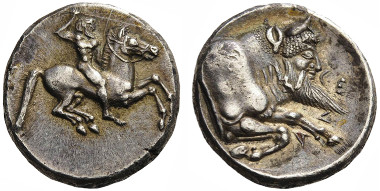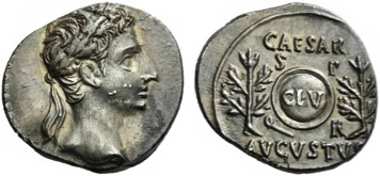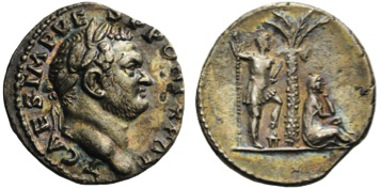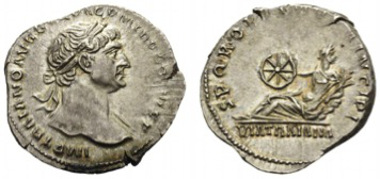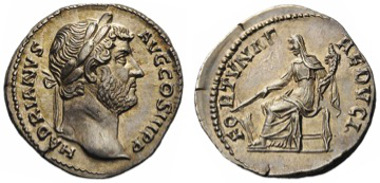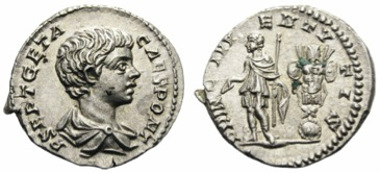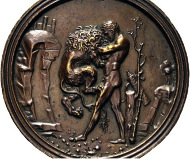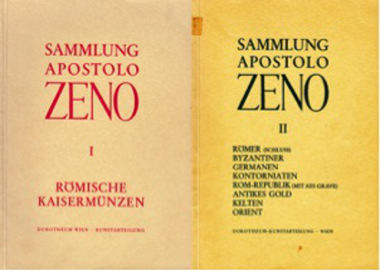26-03-2014 – 01-01-1970
Nomos Webshop March
Nomos webshop March
56 new items have been added to the Nomos webshop. This carefully selected group contains fascinating pieces ranging from a stater from ancient Italy struck in Metapontum around 500 BC to a 17th century Dutch medal produced as a wedding or betrothal gift, of a type that was very popular among the rich bourgeoisie.
The focus of today’s offer is on Roman Republican and Roman Imperial coinage; with different denominations starting with a small, but very elegant, quadrans to an aureus, which was 1600 times its value! Two excellent silver denarii of Augustus are particularly interesting: they show the clipeus virtutis, which was – according to the Res Gestae Divi Augusti, the funerary inscription giving the achievements of Augustus – a golden shield displayed in the Curia Iulia that was given to Augustus by the Senate and the Roman people in commemoration of his virtue, piety, justice and clemency. Both coins are remarkable for their extraordinary state of preservation and attractive old cabinet tone.
Two other specimens struck under Titus, one in the name of Divus Vespasian, commemorate the Roman victories in the Jewish War, which went on until AD 73. The Flavians could not issue coins referring to their victory over Vitellius since these were victories in a civil war, in which Romans killed Romans. Thus, the conquest of a rebellious province, which in some ways could be equated with an external enemy, could be portrayed as a glorious event that would unite all Roman citizens. They either show a mourning figure of Judaea next to the victorious emperor or Victory who was the personification of Roman triumph. Another highlight in regard to its outstanding condition and historical importance is the denarius commemorating Trajan’s construction of the route from Beneventum to Brundisium. According to ancient sources it was paid for with the emperor’s personal funds. Strabo, the contemporary Greek geographer, tells us that people saved a whole day of travel by using the Via Traiana instead of the old Via Appia.
Finally, the new additions include a number of interesting and important old auction sale catalogues, including the collections of Apostolo Zeno (1668-1750), Walter Niggeler, and Patrick A. Doheny.
The early coins of Gela are remarkable for their lifelike portrayal of the city’s patron river god, shown as a man-headed bull. This representation goes back to that of Acheloos, a river god from northwest Greece, and initially was only of him, but the type became extremely popular and was used for local river gods all over the Greek world. The nude and bearded horseman on the obverse may well be thought to be chasing the god: preventing him from indulging in one of his destructive rages! This is, in fact, why river gods were shown as bulls – so many rivers in Sicily, Magna Graecia and Greece itself were calm during most of the year, but they all could become dangerous, raging torrents after a flash flood or during the Spring run offs.
14021: C. Piso L.f. Frugi. 67 BC. Denarius. A lovely example with clear surfaces and a most attractive old cabinet tone. Good very fine. Price: 650 CHF.
The reverse of this coin refers to the games held in the name of Apollo that have been taking place since 212 BC. The one responsible for the procedure was praetor C. Calpurnius, an ancestor of the moneyer. One of the most expected games were horse races as the reverse of the silver denarii struck under the name of C. Calpurnius and his father L. Calpurnius demonstrate. In particular, this type is not rare, but it steals the show with its beautiful head of Apollo well struck and attractively toned.
14045: Augustus. 27 BC-AD 14. Denarius. A magnificent example with a spectacular portrait and a perfect old cabinet tone. Great style. Minor die flaws on obverse and slightly off-centered, otherwise, extremely fine. Price: 2,250 CHF.
The CL V on the reverse of this issue represents the clipeus virtutis, which was – according to the Res Gestae Divi Augusti, the funerary inscription giving the achievements of Augustus – a golden shield displayed in the Curia Iulia that was given to Augustus by the Senate and the Roman people (Senatus PopulusQue Romanus) in commemoration of his virtue, piety, justice and clemency. Even though it seems to be obvious that Augustus must have been awarded the shield right after he achieved absolute power and declared the restoration of the Republic, Sydenham suggests ‘that there is no decisive evidence as to the exact date at which the golden shield was conferred, but the coins on which it is represented are of later date than the year BC 27’. When, in 19 BC, the Parthians returned the standards they had captured from Crassus in 53, there would have been an excellent opportunity to once again recall Augustus’ pietas, one of the virtues recorded on the clipeus.
14051: Tiberius. AD 14-37. Aureus. A brilliant example with much of its original mint luster. Perfectly struck on both sides. Minor die flaw on obverse at 3 o’clock, otherwise, extremely fine. Price: 8,750 CHF.
The gold coinage of Tiberius must have been enormous. It was struck in the great branch mint of Lyon and was, as a class, one of the most used gold coinages in Roman history. These pieces are found all over the Empire and beyond – they were very popular in India where they were imported as payment for the spices and luxuries the Romans craved. Nevertheless, the fact that these coins were so popular means that they were also extensively used and many lasted in circulation until at least the 2nd century AD. Thus, a lovely piece like this, so well centered on the obverse and in such fine condition, is not at all common.
14001: Titus. As Caesar, 69-79. Denarius. Very rare. An unusually nice, toned example. Struck on a slightly tight flan with some minor areas of flatness, otherwise, extremely fine. Sold.
The Roman victories in the Jewish War, which went on until 73, were commemorated with a great outpouring of coinage minted in Rome and elsewhere. The Flavians could not issue coins referring to their victory over Vitellius since these were victories in a civil war, in which Romans killed Romans. Thus, the conquest of a rebellious province, which in some ways could be equated with an external enemy, could be portrayed as a glorious event that would unite all Roman citizens.
13965: Trajan. AD 98-117. Denarius. An excellent example of a historically significant coin. Well struck and with some original luster. Reverse slightly off-centered, otherwise, extremely fine. Price: 1,250 CHF.
This coin commemorates Trajan’s construction of the route from Beneventum to Brundisium. According to ancient sources it was paid for with the emperor’s personal funds. Strabo, the contemporary Greek geographer, tells us that people saved a whole day of travel by using the Via Traiana instead of the old Via Appia.
13868: Hadrian. AD 117-138. Denarius. A lustrous coin with a beautiful tone and an elegant portrait. Good extremely fine. Ex Tkalec, 29 February 2008, 467. Sold.
When Hadrian’s father died in 85/6 (Hadrian was then around 10), his cousin Trajan became his guardian. He was brought up in public service and, as the emperor’s only male blood relative was the de facto successor. As emperor he was a very conscientious administrator who insisted on traveling all over the empire to ensure it was all governed and organized properly. He also wanted to ensure that the empire was protected by either natural or man-made frontiers (Hadrian’s Wall in Britain is a perfect example), thus making his abandonment of Trajan’s last conquests an obvious decision. Hadrian was surely the most cultured of all the Roman emperors, being passionately interested in architecture, art, and literature. His coinage reflect those interests and bear portraits that are among the finest in the entire Roman series. The early ones, designed when he first came to the throne, are very realistic, showing a still thin and youngish man (even though he was then over 40). The late portraits of Hadrian have an increasingly noble character about them and appear to avoid any real depiction of aging. This is in contrast to the coinage of Marcus Aurelius, which conscientiously shows the emperor changing from a handsome youth into an elderly man, worn down with the cares of empire. It is possible that no other emperor insisted on having such an elegant series of portraits as did Hadrian, though this is not so surprising given his philhellene tendencies and the obvious interest he took in the way he was portrayed.
13362: Italy. c. later 16th century. Medal. A one-sided roundel, produced in the workshop of Moderno, by the “Maestro dei Tondi ingranditi”. An early cast, but with some casting faults, especially at the bottom. Fields somewhat smoothed. Lovely brown patina with some golden highlights, about extremely fine. Price: 2,250 CHF.
This is much rarer as a circular plaquette than it is as a simple rectangular piece.
If you want to take a look at the Nomos webshop please click.




